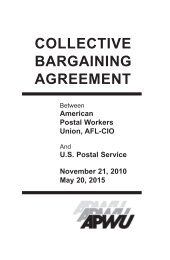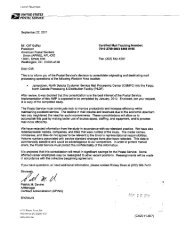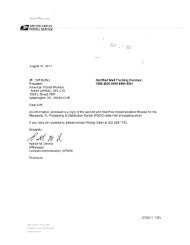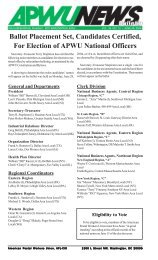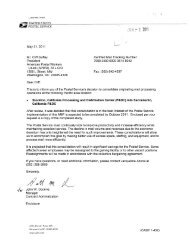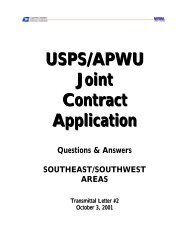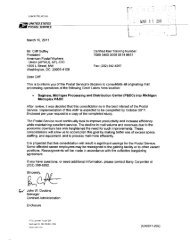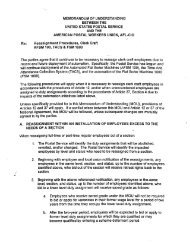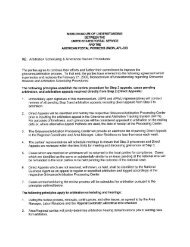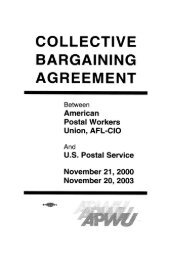Handbook RE-6 - Facilities Environmental Guide - APWU
Handbook RE-6 - Facilities Environmental Guide - APWU
Handbook RE-6 - Facilities Environmental Guide - APWU
You also want an ePaper? Increase the reach of your titles
YUMPU automatically turns print PDFs into web optimized ePapers that Google loves.
ContentsIntroduction1-21 Introduction1-1 PurposeThis guide provides Postal Service <strong>Facilities</strong> personnel with policies,procedures, and guidelines pertaining to facilities-related activities that mayaffect human health and the environment. Increasingly stringent federal,state, and local environmental laws and regulations have been enacted overthe past 25 years. These laws and regulations affect almost every aspect ofPostal Service activities, ranging from small projects to large and complexprograms. Many Postal Service activities, such as real estate acquisition anddisposal, construction, renovation, and Post Office expansion and closure,are subject to numerous environmental regulatory controls. This guide servesas a tool for identifying and managing environmental impacts associated withfacilities real estate transactions.The intent of this guide is to improve the internal management of the PostalService and is not intended to, nor does it, create any right, benefit, or trustresponsibility, substantive or procedural, enforceable at law or equity by anyparty against the United States Postal Service. This guide is not a PostalService regulation; it concerns internal procedures and practices that do notaffect individual rights and obligations. It also does not create any right tojudicial review involving compliance or noncompliance with the proceduresestablished by this guide.1-2 OrganizationThe other chapters in this guide discuss the following topics: Chapter 2, The National <strong>Environmental</strong> Policy Act Process.Chapter 2 provides guidance on how to comply with the National<strong>Environmental</strong> Policy Act (NEPA), that is, how to evaluate theenvironmental impacts that the Postal Service’s proposed actions mayhave on the physical environment. This chapter explains when NEPAapplies to a project, how to use the <strong>Facilities</strong> <strong>Environmental</strong> Checklist tofacilitate the NEPA process, how to apply categorical exclusions, whenand how to prepare an <strong>Environmental</strong> Assessment, and when an<strong>Environmental</strong> Impact Statement is necessary. It also includesinformation about the national <strong>Facilities</strong> NEPA Repository that containscopies of NEPA documents to facilitate the use of the reference<strong>Handbook</strong> <strong>RE</strong>-6, November 20041-1
Contents1-2 <strong>Facilities</strong> <strong>Environmental</strong> <strong>Guide</strong>categorical exclusion included in the Postal Service NEPAimplementing regulations. Chapter 3, <strong>Environmental</strong> Regulatory Requirements. Chapter 3provides guidance on regulatory compliance issues currently requiredby various federal statutes and regulations. This chapter is divided intotopics devoted to regulatory (such as air, water, including the newestregulations for floodplains and wetlands, and endangered species),socioeconomic (such as historic preservation, which includes the PostalService Fine Arts Collection, and environmental justice), and otherenvironmental (such as biohazards, asbestos, and lead policies thatmay affect the design and construction of facilities) areas. Most topicscontain a flowchart outlining the initial and ongoing requirements foreach environmental area.Note: Many regulatory compliance issues identified during theplanning process require ongoing activities throughout theconstruction phase and into the operational phase in order for thePostal Service to be in compliance with various environmental laws.Chapter 4, <strong>Environmental</strong> Due Diligence. Chapter 4 providesguidance on how to successfully complete an environmental duediligence investigation. In the due diligence process, the prospectivepurchaser investigates the property to identify recognizedenvironmental conditions and potential environmental risks associatedwith past uses of real estate. The investigations are designed to informthe Postal Service of potential environmental problems, such as thepresence of underground storage tanks or friable asbestos; to minimizethe risk that the site and/or building contains hazardous or toxicsubstances; and to protect the Postal Service from potential practicaland legal consequences under various federal environmental statutes.Chapter 4 explains when and how the various environmental siteevaluations are performed.Chapter 5, <strong>Environmental</strong> Oversight of Design and Construction.Chapter 5 describes environmental activities that should be undertakenduring the design and construction phases of a project. Part of theseactivities are sustainable design and beneficial landscaping. To supportthese two design goals, the chapter summarizes some of thesuccesses in innovative design and construction technologies that havebeen applied to a wide range of types and sizes of Postal Servicefacilities.Note: Regulatory compliance issues that are discussed inChapter 3 and identified during the planning process may carryover into the construction and operational phases of a project.1-2 <strong>Handbook</strong> <strong>RE</strong>-6, November 2004
ContentsIntroduction1-3.1Delegates at the New York Convention to Ratify the Federal Constitution, 1938 Mural by GeraldFoster Located in Poughkeepsie Post Office, New YorkThis image illustrates the diversity of the national collection housed in our facilities. Murals in the Postal Service’s Fine Arts Collection were commissionedby the former Treasury Department’s Section of Painting and Sculpture (later renamed the Section of Fine Arts). See 3-4.7 for more information.1-3 <strong>Environmental</strong> Planning and Evaluation1-3.1 <strong>Guide</strong>linesThe Postal Service must consider the environmental consequences ofproposed <strong>Facilities</strong> actions before their implementation. <strong>Environmental</strong>planning begins early in the development stage of a proposed action. Duringthis stage, when the Postal Service is actively preparing to make a decision,the environmental effects of that decision must be thoroughly evaluated. ThePostal Service should use the evaluation process to ensure soundenvironmental and business planning, to identify environmental complianceissues, and to minimize legal obstacles and costly time delays due tolitigation. <strong>Environmental</strong> planning fits into business planning at every stage ofdecision making and accompanies an action as it proceeds through itsbusiness life-cycle, with analysis, review, management oversight, andapproval at each step.<strong>Environmental</strong> planning entails several discrete activities, including fulfillingthe requirements of NEPA, identifying and commencing various compliancerequirements, evaluating potential contamination of property in accordancewith the due diligence process, and performing other relevant environmentalevaluations. Each environmental planning activity may involve several levelsof analyses. The results from earlier evaluations will form the basis fordetermining the need to proceed to more extensive and detailed studies.When considering proposed actions that may present environmental issues,environmental specialists, coordinators, planners, decision makers, and otherofficials responsible for Postal Service actions will, when appropriate, do thefollowing:Use a systematic approach, integrating environmental design intoplanning and decision-making processes.Identify environmental effects and values and appraise them inconjunction with economic and technical analyses.<strong>Handbook</strong> <strong>RE</strong>-6, November 20041-3
Contents1-3.2 <strong>Facilities</strong> <strong>Environmental</strong> <strong>Guide</strong>Ensure that project plans, time lines, cost projections, and decisionsreflect environmental requirements, such as costs and time frames forenvironmental studies or the implementation of necessary mitigationmeasures.1-3.2 Intergovernmental Cooperation and CommunityContactCompliance with the Intergovernmental Cooperation Act (ICA), 31 UnitedStates Code (U.S.C.) Section 6501, is a critical step in the planning stages ofa facilities action. Although the ICA is not an environmental law and does notimpose environmental requirements, compliance with the ICA is often closelyassociated with, and an integral part of, the environmental planning process.The following is a short discussion of the ICA and Postal Servicerequirements.Postal Service regulations concerning intergovernmental review must befollowed. These regulations, 39 Code of Federal Regulations (CFR) 778,Intergovernmental Review of Postal Service Facility Actions, detail PostalService intergovernmental review obligations and encompass the ICArequirements. In accordance with these regulations, the Postal Servicepublished a Federal Register notice identifying the following facility projectactions for which the ICA applies: New facility construction, owned or leased. Expansion of an existing facility.Purchase or lease of an existing building if new or substantiallyenlarged occupancy is involved.Real property disposal.Other Postal Service actions that might directly affect state or localcommunity plans.ICA regulations are intended to foster an intergovernmental partnership byutilizing state processes and state, regional, and local coordination to reviewproposed federal development projects. Federal agencies must provideopportunities for consulting and communicating with state and local planningofficials and make every effort to accommodate their legitimate concerns. ThePostal Service has an obligation to maintain records to document factors thatlead to a decision. These records are maintained so that a reviewing courtcan determine if the Postal Service fully considered local planning objectives.In addition to the ICA, the Postal Service must comply with its communitycontact regulations (see 39 CFR 241). These regulations, published October5, 1998, are also available on the Internet at www.gpoaccess.gov/cfr/index.html. Additional guidance can be found in the Administrative SupportManual (ASM) 518.2, Community Contact, and the Community RelationsRegulations for U.S. Postal Service <strong>Facilities</strong> Projects.1-4 <strong>Handbook</strong> <strong>RE</strong>-6, November 2004
ContentsIntroduction1-3.41-3.3 Use of ContractorsWhen a project requires environmental technical expertise, outsidecontractors may be retained. Contracting out the entire environmentalplanning process, however, should be discouraged. Resources may be usedmore efficiently by conducting environmental planning in-house with thecooperation of <strong>Facilities</strong>, environmental, and legal staff who are familiar withPostal Service policies, regulations, and operations.In any event, in-house staff should serve as program managers andreviewers of work products prepared by contractors. <strong>Environmental</strong> analysesand the development of alternatives and recommendations by contractorsmust be reviewed by the Postal Service’s project stakeholders andresponsible officials. Even though contractors are responsible for meeting allrequirements that pertain to their work, the Postal Service is ultimatelyresponsible for implementing environmental mitigation and relatedoperational activities.Contractors may be hired for the preparation of <strong>Environmental</strong> Assessments(EAs), <strong>Environmental</strong> Impact Statements (EISs), environmental due diligenceassessments (e.g., Phase I environmental site assessments and sitecharacterizations), underground storage tank (UST) surveys, and otherenvironmental studies, including those addressing floodplains, wetlands, andhistoric considerations. The use of contractors is governed by the followingconditions:The firm selected to perform environmental services for a facility actionmust not be the term contractor or any contractor that is selected toperform other services, such as architect-engineer (A-E) design andconstruction services for the same project (e.g., asbestos abatement ifthe term contractor conducted the asbestos survey).A contractor employed to prepare an EA or EIS must certify that he orshe has no financial or other interest in the outcome of the project.The contractor should notify the contracting officer before discussingthe project with the owner, lessor, or their representatives.The contractor must give advance notice to the contracting officer, realestate project manager, or other appropriate Postal Service managerswhen contacting the public and public agencies about the project.1-3.4 DocumentationThe environmental planning process may require the preparation of variousdocuments. For example, the NEPA process could involve the preparation ofan EA and Finding of No Significant Impact (FONSI) or the more extensiveEIS and Record of Decision (ROD). Chapter 2 fully discusses documentationrequirements under NEPA. Similarly, the environmental due diligence processnormally requires at least the Transaction Screen Questionnaire (TSQ), or aPhase I environmental site assessment (ESA), and possibly a moreextensive assessment, such as a site characterization. Chapter 4 discussesthese documentation requirements. Postal Service policy also may require<strong>Handbook</strong> <strong>RE</strong>-6, November 20041-5
Contents1-3.4.1 <strong>Facilities</strong> <strong>Environmental</strong> <strong>Guide</strong>the completion of other documents during the environmental planningprocess.All supporting environmental documents must become an integral part of thefile that documents proposed actions and should be used in thedecision-making process. At the completion of the project, a copy of allenvironmental documentation must be filed at the appropriate facilitiesservice office (FSO) or at <strong>Facilities</strong>, Headquarters, depending on the leadoffice. Copies of all accountable environmental documents (such as permits)must also be transferred to the manager (e.g., postmaster of the facilityinvolved) for filing on site and to the appropriate area environmentalpersonnel.1-3.4.1 <strong>Facilities</strong> <strong>Environmental</strong> ChecklistFor the majority of proposed projects, the Postal Service requires thepreparation of the <strong>Facilities</strong> <strong>Environmental</strong> Checklist (referred to as thechecklist). Although not a NEPA document, this checklist should be used todetermine the applicability of NEPA. A completed checklist cannot be used asa substitute for a required EA or EIS.Note: Separate NEPA documents must be prepared if regulations or thechecklist findings indicate that a NEPA review is required. Refer toChapter 2 for a detailed explanation of how to use the checklist tosupport the NEPA process.In addition to assisting in the NEPA process, the checklist is used to identifypotential regulatory compliance issues, such as permitting requirementsunder the Clean Air Act (CAA), Clean Water Act (CWA), Safe Drinking WaterAct (SDWA), and so forth. These compliance issues are discussed further inChapter 3.1-3.4.2 Record of <strong>Environmental</strong> Consideration1-4 ResponsibilitiesThe Record of <strong>Environmental</strong> Consideration (<strong>RE</strong>C) documents the level ofNEPA review that has been undertaken for a project and must accompanythe project file. This form must be completed even if an EA is not prepared.Chapter 2 explains how to use and complete the <strong>RE</strong>C.Organizational responsibilities are outlined in the following sections.1-4.1 <strong>Environmental</strong> Management Policy<strong>Environmental</strong> Management Policy (EMP), Engineering, Headquarters, isresponsible for:Developing environmental operational programs implementedthroughout the Postal Service.Providing environmental guidance to those facilities that have passedfrom the real estate and construction phase and are now operational.1-6 <strong>Handbook</strong> <strong>RE</strong>-6, November 2004
ContentsIntroduction1-4.4Developing policy and guidance documents designed to facilitatecompliance with NEPA and its implementing regulations.Providing guidance regarding the types of information to be collectedand maintained in order to comply with environmental regulations.Ensuring that appropriate environmental documents are prepared.1-4.2 <strong>Facilities</strong><strong>Facilities</strong>, Headquarters, is responsible for: Overseeing policies governing site acquisition, building design, andconstruction for new facilities. Ensuring functional coordination with the environmental specialists atthe FSOs. Evaluating environmental program risks and impacts as they relate to<strong>Facilities</strong> activities, including acquisition of property, construction,modification, repair and alteration, and disposal. Developing facility environmental guidelines and policies that affectfacilities construction and real estate activities.1-4.3 <strong>Facilities</strong> Service Offices and <strong>Facilities</strong>,HeadquartersThe FSOs and <strong>Facilities</strong>, Headquarters, on major projects are responsiblefor:Implementing policies governing site acquisition, building design, andconstruction for new facilities.Providing technical support for real estate and design and constructionactivities, site investigations, preferred area investigations, and siteselection.Determining the appropriate scope of work and providing technicaloversight of EAs, site contamination assessments, and other studies(e.g., wetlands, floodplains, and permits).Preparing, or coordinating the preparation of, EAs and otherenvironmental analyses for real estate and construction actions that fallwithin their contracting authority.1-4.4 General CounselGeneral Counsel, Headquarters, is responsible for: Ensuring that contracts, EAs, and EISs meet legal requirements. Providing advice on environmental legal issues. Monitoring and reviewing new federal environmental laws andregulations and advising affected Postal Service organizations.<strong>Handbook</strong> <strong>RE</strong>-6, November 20041-7
Contents1-4.5 <strong>Facilities</strong> <strong>Environmental</strong> <strong>Guide</strong>1-4.5 OperationsOperations at all levels is responsible for overseeing the policies governingfacility planning concepts and space criteria for new facilities as detailed in<strong>Handbook</strong> AS-504, Space Requirements.Service to the Farmer, 1939 Mural by Davenport Griffen Located in Carmi Post Office, IllinoisPhotograph by PARMA Conservation.This image illustrates the diversity of the national collection housed in our facilities. Murals in the Postal Service’s Fine Arts Collection were commissionedby the former Treasury Department’s Section of Painting and Sculpture (later renamed the Section of Fine Arts). See 3-4.7 for more information.1-5 References1-5.1 <strong>Handbook</strong>s and Management InstructionsSeveral handbooks provide in-depth discussions about specific <strong>Facilities</strong>programs, including the following: <strong>Handbook</strong> AS-503, Standard Design Critieria. <strong>Handbook</strong> P-2, Design and Construction Purchasing Practices. <strong>Handbook</strong> <strong>RE</strong>-1, Realty Acquisition and Management. <strong>Handbook</strong> AS-506, Architect/Engineer Project Requirements.Several management instructions (MIs) and environmental handbooks mayalso serve as reference and guidance materials (see 1-5.2 and 1-5.3).1-5.2 <strong>Environmental</strong> Information SystemsA large amount of environmental information is available online to the PostalService. The EMP Web site (available at http://blue.usps.gov/environmental)contains a great deal of information, including directories of points of contact,environmental program information, and a library of environmental referencematerials that can be downloaded. The references include Postal Servicepolicy documents, MIs, maintenance management orders (MMOs), andfederal and state regulations. The Web-enabled <strong>Environmental</strong> ManagementInformation System (WebEMIS) also provides data tracked on the progress ofspecific environmental topics.1-8 <strong>Handbook</strong> <strong>RE</strong>-6, November 2004
ContentsIntroduction1-6For those without Postal Service Intranet access via the Postal RoutedNetwork (PRN), you can download and view reference materials throughwww.usps.com/environment/. For environmental information not available onthe Web, such as information about radon and testing kits, contact EMP at202-268-6012.The Web site address for <strong>Facilities</strong> is http://blue.usps.gov/facilities;referenced materials can be found on the file transfer protocol (FTP) siteaccessed from the Design and Construction Web page or through the menuboxes “<strong>Environmental</strong>” and “Historic Images.” All policy and proceduredocuments are found at http://blue.usps.gov/cpim. Maintenance publicationsmay be found at www.mtsc.usps.gov. Other environmentally orienteddocuments can be found on the Safety Performance Management, EmployeeResource Management, Human Resources, Web site athttp://blue.usps.gov/hrisp/spm/welcome.htm.1-5.3 Other ReferencesThis guide serves as the primary Postal Service document for conductingappropriate environmental planning and management for <strong>Facilities</strong>-relatedPostal Service activities. Other Postal Service documents and publicationsmay also serve as useful references, for example, the Purchasing Manual;<strong>Handbook</strong> F-66, General Investment Policies and Procedures; the ASM;facilities bulletins; and 39 CFR 775, <strong>Environmental</strong> Regulations, and 776,Floodplain and Wetland Procedures. In addition, other agencies may haveprocedures that apply to Postal Service facility actions, such as the U.S.Army Corps of Engineers (USACE) regulations dealing with the alteration ofwetlands.1-6 Applicable <strong>Environmental</strong> Laws, Regulations, andExecutive OrdersMany statutes, regulations, and executive orders (EOs) may come into playwhen carrying out Postal Service facilities actions. Some may requirecompliance as a matter of law; others may require compliance as a matter ofPostal Service policy. These statutes and EOs include the following: Archaeological and Historic Preservation Act. Archaeological Resources Protection Act. Architectural Barriers Act. Clean Air Act.Clean Water Act (common name of the Federal Water Pollution ControlAct).Coastal Zone Management Act.Comprehensive <strong>Environmental</strong> Response, Compensation, and LiabilityAct, commonly known as the Superfund Act, and including theSuperfund Amendments and Reauthorization Act.<strong>Handbook</strong> <strong>RE</strong>-6, November 20041-9
Contents1-6 <strong>Facilities</strong> <strong>Environmental</strong> <strong>Guide</strong>Emergency Planning and Community Right-to-Know Act.Endangered Species Act.Energy Policy Act.Executive Order 11988, Floodplain Management.Executive Order 11990, Protection of Wetlands.Executive Order 12873, Federal Acquisition, Recycling and WastePrevention.Executive Order 12898, Federal Actions to Address <strong>Environmental</strong>Justice in Minority Populations and Low-Income Populations.Executive Order 12902, Energy Efficiency and Water Conservation atFederal <strong>Facilities</strong>.Executive Order 13006, Locating Federal <strong>Facilities</strong> on HistoricProperties in Our Nation’s Center Cities.Executive Order 13123, Greening the Government Through EfficientEnergy Management.Executive Order 13287, Preserve America.Farmland Protection Policy Act.Federal Insecticide, Fungicide, and Rodenticide Act.Federal Intergovernmental Cooperation Act.Flood Disaster Protection Act.Marine Sanctuaries Act.National <strong>Environmental</strong> Policy Act.National Flood Insurance Act.National Historic Preservation Act.Native American Graves Protection and Repatriation Act.Occupational Safety and Health Act.Ocean Dumping Ban Act.Oil Pollution Act.Pollution Prevention Act.Postal Service Regulations, Intergovernmental Review of PostalService Facility Actions.Postal Service Regulations, National <strong>Environmental</strong> Policy ActProcedures.Public Buildings Cooperative Use Act.Resource Conservation and Recovery Act.Safe Drinking Water Act.Toxic Substances Control Act.Wild and Scenic Rivers Act.Additional laws and regulations may be identified in the planning process andmay require compliance. State and municipal laws and regulations, which areoften more stringent than their federal counterparts, may also require1-10 <strong>Handbook</strong> <strong>RE</strong>-6, November 2004
ContentsIntroduction1-7compliance. Consult with General Counsel if uncertainty exists about whetheror not a particular law or regulation is applicable and requires compliance.1-7 Updates to This <strong>Guide</strong>The national manager of Real Estate, <strong>Facilities</strong>, Headquarters, in consultationwith General Counsel, may issue updates to this guide through transmittalletters, Postal Bulletin notices, and MIs.<strong>Handbook</strong> <strong>RE</strong>-6, November 20041-11
Contents<strong>Facilities</strong> <strong>Environmental</strong> <strong>Guide</strong>This page intentionally left blank1-12 <strong>Handbook</strong> <strong>RE</strong>-6, November 2004




![Dec. 9 letter to Sen. Murray and Rep. Ryan [PDF] - APWU](https://img.yumpu.com/51737602/1/190x245/dec-9-letter-to-sen-murray-and-rep-ryan-pdf-apwu.jpg?quality=85)
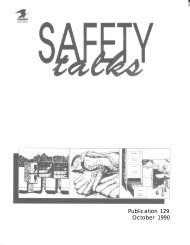
![these offices [PDF] - APWU](https://img.yumpu.com/51694952/1/190x245/these-offices-pdf-apwu.jpg?quality=85)
